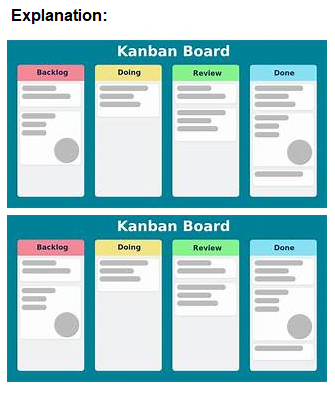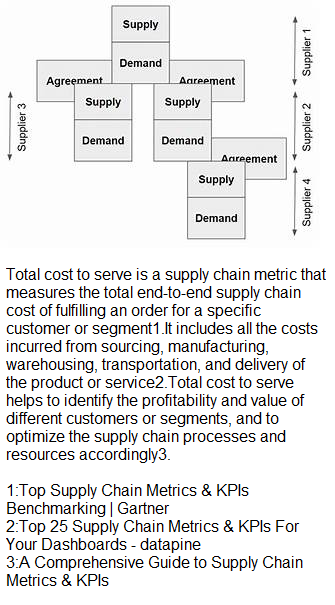To set improvement priorities, the first step is to:
A. build a solid case for change.
B. ensure the solutions are scalable.
C. develop an organizational mapping.
D. have senior management's agreement.
Explanation: According to the ASCM, the first step in setting improvement priorities for supply chain transformation is to create a business case for change1.This involves highlighting how improvements in the supply chain processes will enable the organization to achieve its strategic goals, such as increasing customer satisfaction, reducing costs, enhancing sustainability, and gaining competitive advantage1.The business case for change should also calculate the improvement potential by using quantifiable business and supply chain metrics, such as revenue, profitability, service level, inventory, and carbon footprint1.Moreover, the business case for change should guarantee cross-functional engagement by involving key stakeholders from different functions and levels of the organization, such as sales, marketing, finance, operations, and senior management1.By creating a solid business case for change, the organization can justify the need for supply chain transformation, secure the necessary resources and support, and align the improvement priorities with the business objectives1.
A manufacturing company is implementing new technology in all production lines. To accelerate the change and track the progress, this company should:
A. utilize a push-pull system.
B. adopt define-test-deploy.
C. create visibility.
D. identify current performance drivers.
Explanation: According to the CTSC Exam Content Manual, one of the ways to accelerate the change and track the progress of a new technology implementation is to create visibility1.Creating visibility means sharing the information and data about the change process, such as the objectives, benefits, milestones, challenges, and results, with the relevant stakeholders, such as the employees, managers, customers, and suppliers1.Creating visibility can help to increase the awareness, understanding, and acceptance of the change, as well as to identify and address the issues and risks that may arise during the change1.Creating visibility can also help to monitor and evaluate the performance and impact of the new technology, and to provide feedback and recognition to the change agents and participants1. The other options are not the best ways to accelerate the change and track the progress of a new technology implementation, as they are more related to other aspects of the supply chain or the change management.Utilizing a pushpull system is a way to balance the demand and supply in the supply chain, but it does not directly affect the speed or the measurement of the change2.Adopting define-test-deploy is a way to implement a new technology in a phased manner, but it does not necessarily accelerate the change or track the progress, unless it is combined with other methods, such as agile or lean3. Identifying current performance drivers is a way to understand the factors that influence the supply chain performance, but it does not help to implement a new technology, unless it is followed by a gap analysis and a solution design.
A widget manufacturing company wants to embark on a digital supply chain transformation journey. Which of the following activities should the company's leadership focus on in the beginning?
A. Identifying areas of the business that can benefit the most from this in order to prioritize resources
B. Incorporating this initiative in the budgeting process and asking the procurement team to research potential vendors in this space
C. Providing a clear roadmap to the business and establishing conditions for greater process integration and cross-functional collaboration
D. Hiring digital consultants and subject matter experts that can effectively advise the company at all stages in this journey
Explanation: According to the ASCM CTSC Exam Content Manual, one of the first steps in initiating a digital supply chain transformation is to “identify the business drivers and opportunities for transformation, and prioritize them based on their potential impact and feasibility” (p. 15). This helps the company’s leadership to align the transformation objectives with the strategic goals of the organization, and to allocate resources accordingly. The other activities mentioned in the options are also important, but they should be done after the initial identification and prioritization of the areas of the business that can benefit the most from the transformation.
A company wishes to extend its responsive demand-supply matching (RDSM) capabilities to include predictive maintenance of its delivery trucks. This indicates additional focus on which digital discipline?
A. Sense
B. Collaborate
C. Optimize
D. Respond
Explanation: According to the CTSC Exam Content Manual1, the optimize digital discipline focuses on using data and analytics to improve operational efficiency and effectiveness, such as predictive maintenance, asset utilization, and resource allocation. Responsive demand-supply matching (RDSM) is a capability that falls under the optimize discipline, as it aims to balance supply and demand in real time using data-driven insights and actions. Extending RDSM to include predictive maintenance of delivery trucks would indicate additional focus on the optimize discipline, as it would help reduce downtime, costs, and risks associated with truck breakdowns.
A firm wants to update its supply chain network design to enable auto re-sizing based on changes in product flow within the network. This update will place the firm at what stage in the Capability Maturity Model within Supply Network Design?
A. Advanced
B. Typical
C. Ad-hoc
D. Leading
Which of the following strategies deals with making a shift from traditional ways of operating to ways that make extensive use of data, technology, and business models in innovative ways?
A. Integrated business planning
B. Supply chain analytics
C. Supply chain optimization (SCO)
D. Digital supply chain transformation
What operational framework references a pull system that includes visual cards to represent a work item?
A. Agile
B. Crystal
C. Scrum
D. Kanban

A consumer electronics manufacturer has undertaken a transformation of its supply network design. In order to increase customer service, they acquired more dedicated space on a cargo airline to reduce its use of ocean transport. The manufacturer is expecting which metric shifts due to this change?
A. Expected transportation costs to increase and expedited delivery upgrade costs to decrease
B. Expected transportation costs to increase and expedited delivery upgrade costs to increase
C. Expected transportation costs to increase and network path touches to increase
D. Expected transportation costs to increase and demand volume growth to decrease
Explanation: air transport is generally more expensive than ocean transport, but also faster and more reliable1. Therefore, by acquiring more dedicated space on a cargo airline, the manufacturer can expect its transportation costs to increase, but also reduce its need for expedited delivery upgrades, which are usually costly and inefficient2.The other options are not likely to occur, as air transport does not necessarily increase the network path touches or decrease the demand volume growth.
Which of the following behaviors is the best example of a digital supply chain integrator?
A. Timely communication of issues through functional silos made electronically
B. Reaching across functional and technological boundaries to seek information and understanding
C. Sharing updates of digital supply chain projects though intranet and e-newsletters
D. Conducting regular training programs for all employees on the company's supply chain tools
Explanation: According to the ASCM CTSC Exam Content Manual, a digital supply chain integrator is a role that involves connecting the digital and physical supply chain elements, and enabling the flow of data and information across the end-to-end supply chain1. This requires reaching across functional and technological boundaries to seek information and understand-ing, and to collaborate with internal and external partners to optimize the supply chain performance2. The other options are not specific to the digital supply chain integrator role, as they are common behaviors for any supply chain professional.
Which of the following metrics is the most appropriate to use in order to measure the total end-to-end supply chain cost in fulfilling an order?
A. Cash-to-cash cycle time
B. Order fulfillment cost
C. Return on assets
D. Total cost to serve

Which of the following trends is a driver for change in agile operations execution?
A. Research and development (R&D) cycles are fast and inexpensive.
B. Products are becoming less complex and using less raw materials.
C. Product labeling is becoming more enhanced, including translation into additional languages.
D. The requirements for transaction documentation, including use of blockchain, are decreasing.
What measure should be adopted for supply chains to become more resilient to unanticipated disruptions?
A. Implement internal standards of risk awareness and response.
B. Ensure that there is clear responsibility for identifying risk.
C. Decrease inventory levels to the minimum level possible.
D. Increase levels of agility and velocity.
Explanation: According to the CTSC Exam Content Manual1, one of the key capabilities for supply chain resilience is agility, which is the ability to respond quickly and effectively to unanticipated disruptions. Agility enables supply chain professionals to adapt to changing customer needs, market conditions, and operational challenges. Another key capability for supply chain resilience is velocity, which is the speed at which products and information flow through the supply chain. Velocity enables supply chain professionals to reduce lead times, improve service levels, and increase customer satisfaction. Therefore, increasing levels of agility and velocity is a measure that should be adopted for supply chains to become more resilient to unanticipated disruptions. Option A, implementing internal standards of risk awareness and response, is a measure that can help mitigate the impact of disruptions, but it does not necessarily increase the resilience of the supply chain. Option B, ensuring that there is clear responsibility for identifying risk, is a measure that can help prevent or reduce the likelihood of disruptions, but it does not necessarily increase the resilience of the supply chain. Option C, decreasing inventory levels to the minimum level possible, is a measure that can reduce costs and waste, but it can also increase the vulnerability of the supply chain to disruptions.
| Page 4 out of 13 Pages |
| Previous |